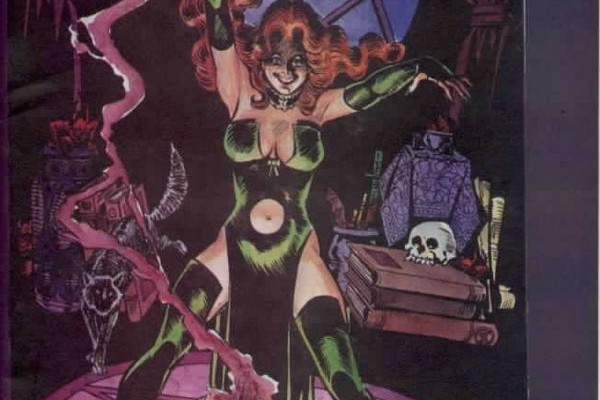 The first issue of Kev O’Neill’s special effects fanzine: Just Imagine, May 1975
The first issue of Kev O’Neill’s special effects fanzine: Just Imagine, May 1975
The initial impetus behind this issue was to reflect on the fanzine as a format. Embedded within histories of self-publishing, niche and underground groups, fandom, pop and rock idols, or even further political pamphlets, zines have fed and resulted from science fiction, comics, punk, queer, feminist imaginaries, and DIY aesthetics for decades. The zine is a curious piece of publishing that has raised relevant questions about the ways in which various communities and readerships express themselves as forces of counterculture. It has also been an expression of independent publishing and self-organization’s modes of operation.
With the employment of manipulated, copied and recycled images, and the appropriation and subversion of advertising, newspaper, musical, popular and technical imagery, early zine formats can be read as symptoms of a particular utilization of pop culture, not just its instigators.
Subverting both design and editorial conventions in favor of a form of anti-expertise, the fanzine encapsulates an intense faith in visuality as a form of communication, mobilization, and representation. Inextricably linked with literary, cinematic, and sonic genres such as science fiction, punk, and pulp fiction, it displaces their vocabulary into effective and serial modes of address.
Before (or even aided by) the onslaught of digital media and its derivatives, and in opposition to mainstream media and consumer culture, employing their imagery for contrarian purposes, fanzines were thought to have occupied a unique, autonomous position. Their peculiar economy of print, circulation and distribution, their cheaply produced often stapled, photocopied formats created an ethos as independent and even allegedly subversive platforms.
Is the fanzine as a format – with its materials, layouts and contents, which bear a striking resemblance to the images of the cultures that it reproduces and appropriates — capable of reflecting on itself as an apparatus, its implications and modes of dissemination? Is the fanzine genre a comment on the circulation of subcultures and their image deluge, or a reproduction of those very mechanisms and tactics? Can zines be read as symptoms of a particular moment, its further instigators, or are they capable of identifying or critically assessing the ethos of a particular historical moment of which they form part?
Furthermore, traditional zine culture’s seemingly ageist and racially narrow dimensions, as well as the contemporary reign of blogs and electronic media and their alleged moves away from a radical undergrounds and move towards a mainstream, raises some questions. How can we assess fanzines’ contemporary relevance and legacy? What are the potentialities and limits of fandom in a cultural landscape seized by commodification strategies such as band reunions, reissues and anthologies?
This is not an overview or history of fanzines, and thus does not aim to address all these issues. It seeks to filter and channel some of the questions raised above through four contributions of varying registers that dance around the different implications of zine-ness. The contributor essays do so through mobilizing the different features of or phenomenon produced by the zine via four nodes: fandom and iconicity, parody/repurposing, cyberculture and abstraction, and alternate modes of distribution and circulation.
Leila Pourtavaf’s Mobilivre-Bookmobile project and the Bookmobile Collective, encapsulate some of the modes of production and circulation mobilized around publications such as the fanzine. The itinerant nature of the bookmobile and the networks of communication and collaboration fostered by the collective, resonate with the anti-authoritarian politics of zines, as manifested both in aesthetics and in the methods of reproduction/circulation. Currently in the process of finishing a book that attempts to archive the Bookmobile project, Pourtavaf’s contribution revisits the project a decade later, and considers processes of disillusionment and the relevance of fanzines therein.
Artist and musician Steven Warwick (aka Heatsick), who produces artist books and zines, was asked to create visual works that resonate with a zine content, aesthetic and mode of address from within his own practice. His three images, THUS SPAKE ZARA, CREATIVE CLASS, and SELF HELP employ ubiquitous brand logos in a bid to reuse, parody and evoke tropes of consumption, culture, and class at work in the ways images are produced and recognized.
Fiona McGovern reflects on the recent resurgence of exhibitions and edited volumes dedicated to visual artist Kim Gordon, and Sonic Youth, the cult band of which she was the founding member. She looks at the ways in which these formats and modes of exhibition negotiated the persona created by Gordon herself. Navigating the domains of performance, writing, and exhibition, McGovern tries to discern the situations in which the boundaries between fandom, scholarship and contemporary art are blurred in view of Gordon’s multi-disciplinarity (musical, visual, written or otherwise). Drawing on her experience interviewing Gordon for mono.kultur, McGovern demonstrates how the issue’s aesthetic both borrows and departs from a fanzine ethos.
In “Spinal Jetty”, artist and writer Brian Rogers unearths the archives of Abstract Culture, a now defunct online and print journal/zine founded by Warwick University’s Cybernetic Culture Research Unit (CCRU). Taking inspiration from strategist and writer Benedict Singleton, Rogers untangles the complex hybrids of fiction, design, theory, and philosophy engineered by Abstract Culture, via a conception of “plot” as both narrative device and form of design. Rogers finds, in Abstract Culture, an impulse to forge oblique associations between text and graphics — a strategy characteristic of this zine. In addition, he identifies in its experimental texts and modes of writing an alliance with the polymorphous and elusive sonic, visual and literary genres the journal/zine attempts to theorize. Rogers argues, Abstract Culture seemed to diagnose and anticipate, as opposed to respond or cater to, a certain community and way of being.